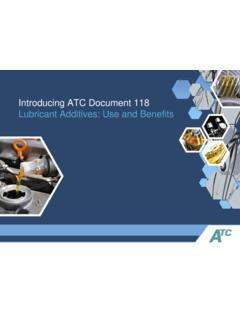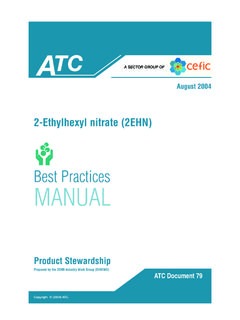Transcription of Fuel Additives: Use and Benefits - Welcome to ATC
1 fuel additives : Use and BenefitsSeptember 2013 / AtC DoCument 113 Technical Committee of Petroleum Additive Manufacturers in EuropeABSTRACT 4 EXECUTIVE SUMMARY 5 INTRODUCTION 7 Aim 8 Scope 8 AtC
2 8 AtC organisation and objectives 9the petroleum additive industry 10the fuel additive business 10 Development of new additives 10 Cost complexity and confidentiality 10 HISTORY OF ADDITIVE DEVELOPMENT 13the pre-additive period until 1921 14the main steps of fuel additive development 1920s to the present 14 fuel additive types and history 15main additive component families 16multi-Functional additives 16 THE ROLE OF fuel additives IN THE VEHICLE 19 Vehicle hardware/oem trends 20ensuring no-harm for fuel additives 21 CHEMISTRY OF GASOLINE fuel additives 22 Deposit Control additives 23 Fluidisers / Carrier oils 24 Friction modifiers 25 Corrosion Inhibitors 26 Antioxidants 27 Conductivity Improvers 27metal Deactivators 28markers & Dyes 28 Demulsifiers / Dehazers / emulsion preventatives 29 Copper / Silver Corrosion 30octane boosters 30 Anti-Valve Seat recession 31 CHEMISTRY OF DIESEL fuel additives 32 Deposit Control additives 32 Cetane number Improvers 33 Cold Flow Improvers 34 Lubricity Improvers 35 Anti-Foam additives 36 Corrosion Inhibitors 37 Stability Improvers (incl.)
3 Antioxidants) 38 Conductivity Improvers 38metal Deactivators 39markers & Dyes 39 Dehazers / Demulsifiers / emulsion preventatives 39 fuel borne Catalysts 40 REFINERY AND TERMINAL additives 42pipeline Drag reducing additives 43 Anti-Icing additives 44 Sulphur mitigating additives (H2S scavengers) 44 ContentsHEATING fuel additives 47 Stability Improvers (incl. Antioxidants) 48 Corrosion Inhibitors 48 Deposit Control additives 48thermal Stability enhancer 48 Lubricity Improvers 49 Combustion Improvers 49 Cold Flow Improvers 49reodourant additives 49 MARINE / RESIDUAL fuel additives 50 Dispersant / Stabiliser additives 51 Demulsifiers / emulsion preventatives 52 Combustion Improver additives 53 Corrosion Inhibitor additives 53 Benefits OF fuel additives TO THE ENVIRONMENT AND CONSUMER 54petroleum conservation 54biofuels (Including renewable and Alternative Fuels) 54 fuel economy 54exhaust emissions 55 Health, Safety and the environment 55 fuel additive user Benefits 55 THE ULTIMATE FATE OF fuel additives 56 Fate by element 56 Fate of nitrogen 56other elements 56 Carbon Dioxide 57 APPENDIX Test Methods and Performance Assessment 62 Testing and Standardisation Organisations 62 Engine Test Procedures 62 Gasoline Injector cleanliness test methods 62 AStm D5598 - 01(2007) Standard test method for evaluating unleaded Automotive 62 Spark-Ignition engine fuel for electronic port fuel Injector Fouling Gasoline Intake valve cleanliness test methods (IVD) 62 CeC F-05-93 - Inlet Valve Cleanliness in the mb m102e engine 62 CeC F-20-98 - Deposit Forming tendency on Intake Valves 63 AStm D5500 - 98(2008)
4 - Standard test method for Vehicle evaluation of unleaded Automotive 63 Spark-Ignition engine fuel for Intake Valve Deposit Formation AStm D6201 - 04(2009) Standard test method for Dynamometer evaluation of unleaded 63 Spark-Ignition engine fuel for Intake Valve Deposit Formation 64 Gasoline no-harm test methods 64 CeC F-16-96 - Assessment of the Inlet Valve Sticking tendency of Gasoline Fuels 64 Combustion chamber deposit test methods (CCD) 64 Diesel Injector cleanliness test methods 64 CeC F-23-01 - procedure for Diesel engine Injector nozzle Coking test 64 CeC F-98-08 - Direct Injection, Common rail Diesel engine nozzle Coking test 64 Laboratory Test Procedures 65 fuel additives : Use and Benefits4the technical Committee of petroleum Additive manufacturers in europe (AtC) has produced this document which describes the chemistry and functions of fuel additives , as well as their role in the development of advanced engine and fuel systems.
5 Product health and safety aspects are also reviewed. this document supersedes Document 52 which was originally published in 1994. that first edition was written to provide information which was not previously available, with the purpose of putting in perspective the Benefits to the environment and the end-user provided by fuel additive technology. this document updates the information and reanalyses the data. In addition, information regarding the size and nature of the fuel additives market in the 27 countries of the european Community (eu-27) is additives : Use and Benefits5 fuel additives : use and Benefits is a document published by AtC, the technical Committee of petroleum Additive manufacturers in europe. member companies of this body currently comprise thirteen speciality chemical manufacturers, including some household names, which together are responsible for the production and supply of almost all the additives used in fuels.
6 Such additives encompass applications for gasoline (petrol) and diesel used for on and off road vehicles and machines, together with use in aviation, marine, power generation and home heating fuels. the document demonstrates the contribution made by fuel additives in these applications to the consumer, industry and the environment, through their ability to optimise desirable fuel properties while suppressing unwanted ones. In this context, the term fuel additive is reserved for a product added to fuel at a concentration of typically less than one structure and organisation of AtC provides for direction from a main committee through working-group sub-committees, which are responsible for performance testing, quality monitoring and health and safety legislation. the aim of AtC activities is to ensure good communication with industry bodies, together with active participation in appropriate technical development and product quality demonstration, to enable current and future products to contribute to optimised fuels and lubricants, meet environmental legislation, and/or resolve potential engine or vehicle problems.
7 The petroleum additive industry is a significant operating sector of the world economy, with a world-wide turnover of about 7,000 million, ( 1,900 million in Europe) and research and development (R&D) spending in 2005 of 400 million ( 115 million in Europe). The industry has 8,400 direct employees world-wide (2,800 in Europe), maintaining some 75 R&D and manufacturing sites globally (25 in Europe).Innovation through r&D remains a constant in an industry based on change, to meet, for example the demands of environmental legislation with consequent effect on fuel specifications. Such activities have significant cost implications, as does the need to comply with european reACH regulations linked to health and safety legislation. meeting these demands poses a significant challenge for the fuel and lubricants additives industry, a challenge which nevertheless the industry has shown it can meet since its infancy in the 1920s when lead alkyl anti-knock additives first proved to be very effective in lifting the very low octane quality of available spark-ignition fuels.
8 Further developments have occurred in almost every decade, for example, additives evolved in the 1930s to enhance fuel stability in response to refinery changes to increase gasoline or middle distillate production, or the evolution of deposit control additives which provide performance gains in automotive fuel systems in the 1950s and 1960s. In a further example, a major improvement in diesel fuel cold weather behaviour and properties resulted from the development of cold-flow improver additives during the 1970s. more recent developments include diesel lubricity additives and fuel borne catalyst products for use with diesel exhaust particulate filters. With the increased use within the european union of renewable blending components such as bio-ethanol in gasoline, and Fatty Acid methyl ester (FAme) in diesel fuel , there exists a future demand for novel additive products to ensure consistent high quality fuel production, and satisfactory vehicle operation.
9 fuel additives : use and Benefits details a wide range of additives employed in refineries, automotive fuels and those for aviation, marine and also for fixed installation use. the document includes a systematic description of the chemistry of each additive, its purpose and its mode of action in its selected application. A section is devoted to the Benefits of fuel additives both to the environment and the consumer, covering for example, fuel economy and exhaust emissions. In addition, consideration is given to the health and safety aspects of additive production and use, and also to the ultimate fate of fuel additives following the combustion process. the technical aspects of fuel additives are well covered, with over sixty references cited, thus providing an excellent basis for further study by those interested in increasing their understanding of this important branch of science.
10 In addition, an appendix provides information about industry-standard test methods used for fuel additive performance assessment. Executive SummaryFuel additives : Use and Benefits6 fuel additives : Use and Benefits7 IntroductionThis paper has been prepared by a task force on behalf of ATC - The Technical Committee of Petroleum Additive Manufacturers in petroleum additive industry develops and supplies products that improve the quality of fuels for use in motor vehicles, aircraft and marine vessels and in fixed installations such as power stations and refineries. These products are developed in co-operation with the petroleum and automotive industries, amongst others. ATC defines a fuel additive as:A chemical substance or preparation, added to fuel , in concentrations typically of less than 1%, to impart or enhance desirable properties or to suppress undesirable the activities of the industry are very well known to its customers in the oil industry, and to its indirect customers in the widespread applications identified, there is very little public domain literature available.



